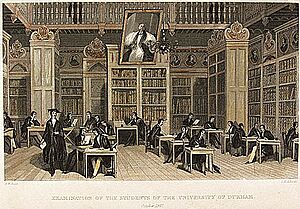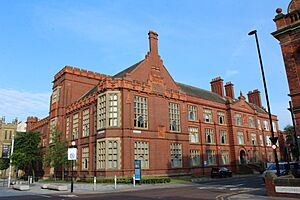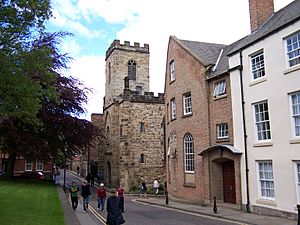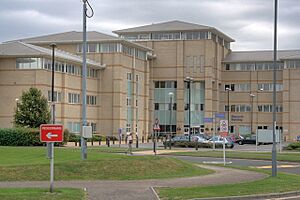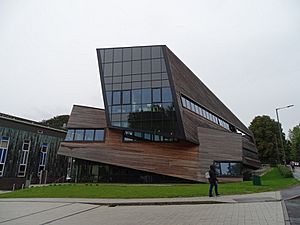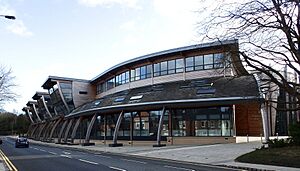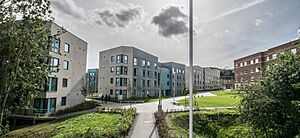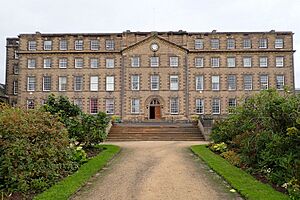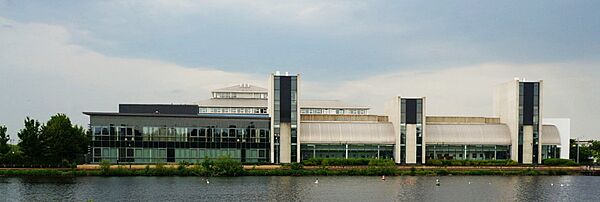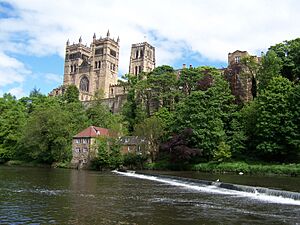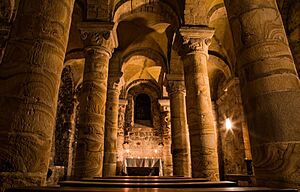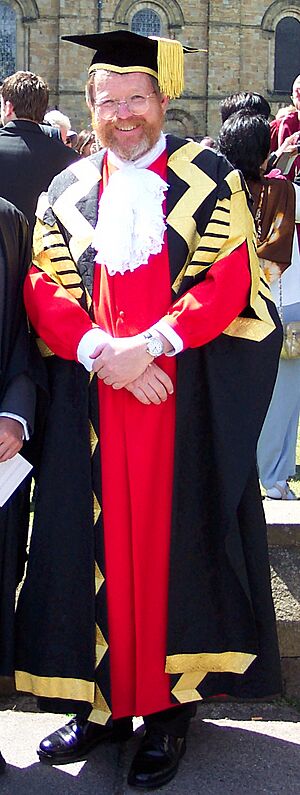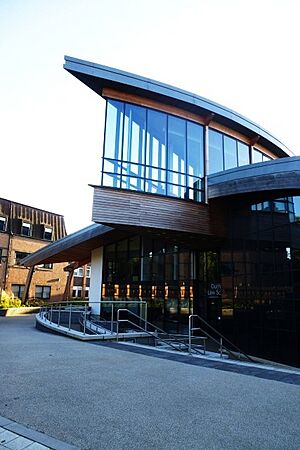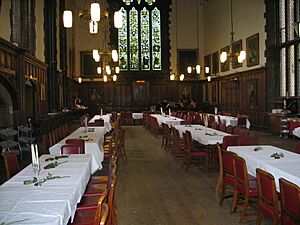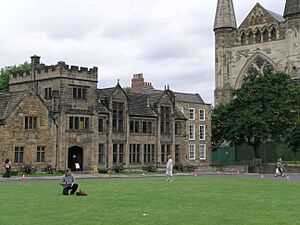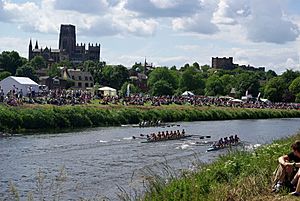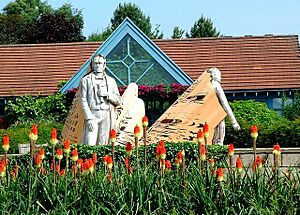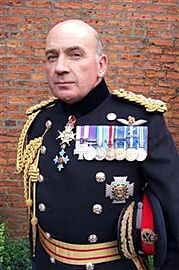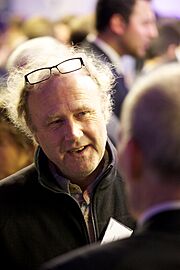Durham University facts for kids
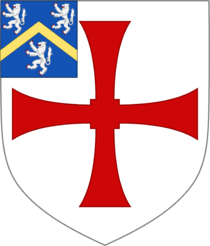
Coat of arms of the university
|
|
| Latin: Universitas Dunelmensis | |
|
Other name
|
The University of Durham |
|---|---|
| Motto | Latin: Fundamenta eius super montibus sanctis |
|
Motto in English
|
Her foundations are upon the holy hills (Psalm 87:1) |
| Type | Public research university |
| Established | 1832 (university status) |
|
Academic affiliations
|
|
| Endowment | £106.6 million (2024; exclusive of independent colleges) |
| Budget | £513.4 million (2023/24) |
| Chancellor | Fiona Hill |
| Vice-Chancellor & Warden | Karen O'Brien |
|
Academic staff
|
2,895 (2023/24) |
|
Administrative staff
|
3,105 (2023/24) |
| Students | (2015/16) 21,265 FTE (2015/16) |
| Undergraduates | (2015/16) |
| Postgraduates | (2015/16) |
| Location |
,
54°46′30″N 01°34′30″W / 54.77500°N 1.57500°W |
| Campus | 257 hectares (640 acres) |
| Student newspaper | Palatinate |
| Colours | Palatinate |
|
Sporting affiliations
|
BUCS, Wallace Group |
| Sports team | Team Durham |
 |
|
| Official name: Durham Castle and Cathedral | |
| Type: | Cultural |
| Criteria: | ii, iv, vi |
| Designated: | 1986 (10th session) |
| Reference #: | 370 |
| Extension: | 2008 |
| Region: | Western Europe |
Durham University is a well-known public research university located in Durham, England. It was officially started by a special law in 1832 and received a royal charter in 1837. It was the first new university to open in England in over 600 years, after Oxford and Cambridge. This makes it the third-oldest university in England.
Durham University is a "collegiate university." This means its main jobs are split between its academic departments and its 17 colleges. The departments focus on teaching and research, while the colleges take care of student living arrangements and well-being.
The university is part of the Russell Group, which is a group of leading research universities in the UK. It also belongs to other important university groups around the world. Durham University owns many historic buildings, including Durham Castle, which dates back to the 11th century. It also helps manage the Durham World Heritage Site with Durham Cathedral. In 2024, Durham was ranked sixth in the UK for its undergraduate teaching.
Contents
History of Durham University
How Durham University Started

Long ago, between 1286 and 1291, monks from Durham set up a place for learning at Oxford. This became Durham College in 1381. Later, in 1545, it was taken over by the Crown.
People in Durham tried several times to start a university in their own city. King Henry VIII and later Oliver Cromwell tried, but these plans didn't work out. Oxford and Cambridge universities didn't want another university to be able to give out degrees.
Finally, in 1832, a special law was passed by Parliament. This law allowed the church leaders of Durham Cathedral to use some of their property to create a university. This happened thanks to Archdeacon Charles Thorp and Bishop William van Mildert. The law was approved by King William IV on July 4, 1832.
Early Years: 1832–1909
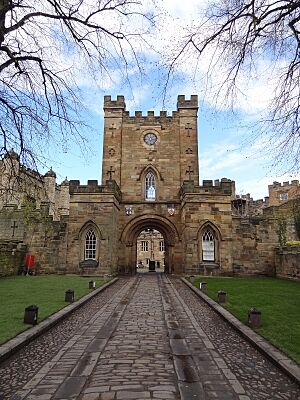
Durham University officially opened on October 28, 1833. In 1837, King William IV gave the university a royal charter, making it an official body. The first students graduated a week later.
At first, students lived in the Archdeacon's Inn. In 1837, Durham Castle, which used to be a palace for the Bishop of Durham, was given to the university for student housing. This is now University College.
In 1846, Hatfield College was founded. It offered affordable rooms and meals, which was a new idea at the time. This idea later spread to other universities. The university also grew by adding a medical school in Newcastle in 1852 and a science college there in 1871.
St Cuthbert's Society was started in 1888 for students who didn't live in colleges. Two teacher-training colleges, St Hild's (for women) and The College of the Venerable Bede (for men), also joined the university. Women first graduated from Durham in 1898.
Durham was also the first English university to connect with colleges in other countries. It partnered with Codrington College in Barbados in 1875 and Fourah Bay College in Sierra Leone in 1876. Students from these colleges could take exams and get Durham degrees. These colleges later became independent.
The Durham Union Society, a debating group, was founded in 1842. The student council, now called the Durham Students' Union, was formed in 1907.
The Federal University: 1909–1963
Over time, the Newcastle part of the university grew very large. In 1909, a new law made Durham a "federal" university, meaning it had two main parts: Durham and Newcastle. The head of Durham University still uses the title "Vice-Chancellor and Warden."
After World War II, the Durham part of the university grew quickly. New colleges like St Aidan's were founded. The university also expanded its science and engineering departments.
In 1947, Princess Elizabeth (who later became Queen Elizabeth II) laid the foundation stones for the new St Mary's College building. It opened in 1952. In 1963, the Newcastle part of the university became its own separate university, Newcastle University. This left Durham University based only in Durham City.
Modern Durham University: 1963–1999
After the separation from Newcastle, Durham University continued to grow. New colleges like Grey College (1959), Van Mildert College (1965), Trevelyan College (1966), and Collingwood College (1972) were built. The botanic garden also moved to a new site in 1970.
The Graduate Society, for postgraduate students, was founded in 1965 (and later became Ustinov College in 2003). In 1988, Hatfield College, which had been only for men, started accepting women.
Growth in Stockton: 1992–1999
In 1991, Durham University started a joint project with the University of Teesside to create a new college in Stockton-on-Tees, about 30 miles south of Durham. This college, called University College Stockton (UCS), opened in 1992.
Teesside University later withdrew from the partnership in 1994, and Durham took full control of UCS. The Stockton site became more integrated with Durham University and was renamed the University of Durham, Stockton Campus (UDSC) in 1998.
21st Century University
In 2001, two new colleges, John Snow and George Stephenson, were created at the Stockton site. A new medical school also opened there. In 2002, Queen Elizabeth II named the Stockton site "Queen's Campus."
In 2005, the university started using "Durham University" as its main name, though its official legal name remained "The University of Durham." Also in 2005, St Mary's College began accepting both male and female undergraduate students. In 2006, Josephine Butler College opened in Durham, the first new college built there since the 1970s.
Durham joined the Matariki Network of Universities in 2010 and the Russell Group in 2012.
Queen's Campus Moves and Durham Expansion
In 2016, the university announced that it would move the colleges and academic activities from Queen's Campus back to Durham City. The medical school was transferred to Newcastle University. Queen's Campus became an International Study Centre for international students.
In 2017, the Ogden Centre for Fundamental Physics opened, providing new labs and offices. The university also announced a plan to invest £700 million to improve its campus, create new jobs, and grow to 21,500 students.
In 2018, two new colleges, a new building for John Snow College and South College, opened at Mount Oswald in 2020.
Durham University Campus
Durham University owns a large area of land, about 257 hectares (635 acres). Most of this is in Durham City. This land includes part of the Durham Castle and Cathedral UNESCO World Heritage Site and many other historic buildings.
One popular spot in Durham City is the Botanic Gardens, which covers 10 hectares (25 acres) and gets over 80,000 visitors each year. The university has over 380 buildings, including 170 student residential buildings.
Durham City Locations
Durham City is the main home of the university, with all its colleges and academic departments. The university's buildings are spread across different areas.
The Peninsula
The Bailey and Palace Green are the historic heart of the university. Here you'll find five colleges, along with departments like music, history, and theology. The Palace Green Library holds special collections, and the archaeological museum is also here.
Elvet
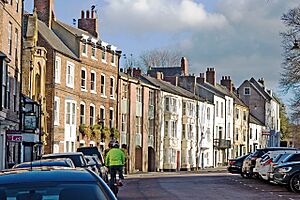
The Elvet area has departments like English studies, philosophy, and modern languages. Many departments are in converted houses, but the Elvet Riverside complex is a larger building. The Durham Students' Union is in Dunelm House, connected to the Peninsula by Kingsgate Bridge. The Racecourse has university sports fields.
Leazes Road
The Leazes Road site used to be home to the School of Education and Hild Bede College. This area is being redeveloped, and a 19th college will be built here. Hild Bede College moved temporarily in summer 2024.
Mountjoy
The Mountjoy site (once called the Science site) has many of the university's science and social science departments. It also houses the university's main offices in the Palatine Centre, the main Bill Bryson Library, and large teaching facilities.
Elvet Hill
Elvet Hill, south of Mountjoy, is home to ten of the colleges, the Botanic Garden, the Business School, and the Oriental Museum.
Other Durham Locations
Ustinov College, for postgraduate students, is in Sheraton Park. Rushford Court is a temporary home for Hild Bede College and is planned to become Durham's 18th college. The business school's Department of Management and Marketing is in the Waterside Building.
Ushaw College
Ushaw College, about 5 miles west of Durham, is a former Catholic seminary. It is a licensed hall of residence for the university and hosts parts of the Business School.
Queen's Campus
Queen's Campus is in Stockton-on-Tees, 30 miles from Durham City. Until 2017–18, it had about 2,000 students and two colleges. The colleges and academic departments moved to Durham City between 2017 and 2018. Now, Queen's Campus is an International Study Centre for students from other countries.
Libraries
Durham University Library started in 1833 and now has over 1.5 million printed items across four locations. The main library is the Bill Bryson Library. The Palace Green Library holds special and historic collections.
In 2012, the university, with the British Library and Durham Cathedral, bought the St Cuthbert Gospel, Europe's oldest intact book. It is shown in both London and Durham. Many colleges also have their own libraries.
Museums
Durham University has three museums open to the public. They hold over 100,000 items.
The Durham University Oriental Museum has over 30,000 objects from Asia, including a large collection from China and Egypt. These collections are considered very important nationally.
The Durham University Museum of Archaeology, located in Palace Green Library, opened in 1833. It focuses on the history of North East England, with items from prehistoric times, Ancient Greece, Roman times, and later periods.
Durham Castle Museum has about 5,000 items related to the castle's history, such as armor, tapestries, and art.
Chapels and Prayer Rooms
Many colleges have Anglican chapels, including the very old Norman Chapel in University College. There are also multi-faith rooms and Muslim prayer rooms available for students.
Environmental Efforts

Durham University is working to become "Net Zero" by 2035, meaning it will remove as much greenhouse gas from the atmosphere as it puts in. It also aims to improve biodiversity on campus by 2032. The university has won several awards for its environmental work, including the Green Gown Awards. It is also part of the Hedgehog Friendly Campus campaign.
University Structure
Academic Year
The academic year at Durham has three terms:
- Michaelmas term: October to December (10 weeks)
- Epiphany term: January to March (10 weeks)
- Easter term: April to June (9 weeks)
There's also an "Induction Week" (or "Freshers' Week") for new students before Michaelmas term starts.
Colleges
Students at Durham belong to one of its 17 colleges. Most students live in their college during their first year. Colleges provide support and social activities. Each college has its own identity and facilities like computer rooms, libraries, and sports fields. They also have their own sports teams and societies.
The 17 colleges are:
 Collingwood
Collingwood Grey
Grey Hatfield
Hatfield John Snow
John Snow Josephine Butler
Josephine Butler South
South St Aidan's
St Aidan's St Chad's
St Chad's St Cuthbert's
St Cuthbert's St Hild & St Bede
St Hild & St Bede St John's
St John's St Mary's
St Mary's Stephenson
Stephenson Trevelyan
Trevelyan University
University Ustinov
Ustinov Van Mildert
Van Mildert
How the University is Run

The university is governed by a group called the Council. This group includes both university staff and people from outside the university. The Council makes sure the university is run well.
The Chancellor is the ceremonial head of the university. The current Chancellor is Fiona Hill, who started in June 2023. The Chancellor's job is to give out degrees and represent the university. The Vice-Chancellor and Warden is the main leader who manages the university day-to-day. Since January 2022, this has been Karen O'Brien, the first woman to hold this role.
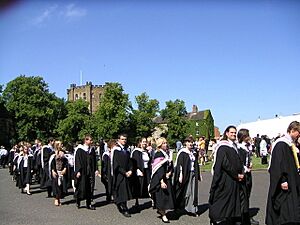
The Senate is another important group that handles academic matters, like teaching standards, exams, and student rules.
Departments and Faculties
The university's teaching departments are grouped into four main faculties:
- Science
- Arts and Humanities
- Social Sciences
- Business
Each faculty has an executive dean. Students can study single subjects or combined degrees like Natural Sciences, Liberal Arts, or Combined Honours in Social Sciences.
|
|
|
Finances
In the financial year ending July 31, 2024, Durham University had a total income of £513.4 million. Its main sources of income were student tuition fees and research grants. The university has a large endowment, which is money given to it to help it grow and operate.
Academic Profile
Research at Durham
Durham University is known for its research. It is part of the Russell Group of leading UK research universities and other international research groups. Durham hosts a powerful supercomputer facility called DiRAC.
The university has many research institutes, such as the Institute for Computational Cosmology and the Institute of Advanced Study. Even though Durham doesn't have a medical school, it has a "Health at Durham" program that focuses on non-clinical aspects of health, like mental and social well-being.
In 2018, Durham won a Queen's Anniversary Prize, a top award in the UK, for its research on parent-infant sleep. In 2021, 45% of Durham's research was considered "world class."
Reputation and Rankings
| National rankings | |
|---|---|
| Complete (2021) | 5 |
| Guardian (2021) | 6 |
| Times / Sunday Times (2021) | 5 |
| Global rankings | |
| ARWU (2020) | 301–400 |
| CWTS Leiden (2020) | 126 |
| QS (2021) |
94= |
| THE (2021) | 172= |
| British Government assessment | |
| Teaching Excellence Framework | Gold |
Durham is seen as one of the UK's most respected universities. It has won the University Challenge TV show multiple times (1977, 2000, 2023, and the 2024–25 Christmas Special). It was also named Sunday Times University of the Year in 2005.
Durham consistently ranks in the top ten universities in the UK. In 2025, it was ranked 5th by the Complete University Guide, 6th by The Guardian University Guide, and 5th by The Times/Sunday Times Good University Guide.
Globally, Durham was ranked 89th in the world by the QS World University Rankings in 2025. It also ranks highly for specific subjects, especially in arts and humanities.
Admissions to Durham University
| 2024 | 2023 | 2022 | 2021 | 2020 | |
|---|---|---|---|---|---|
| Main scheme applications | |||||
| Applications | 34,795 | 34,150 | 34,205 | 32,570 | 32,685 |
| Accepted applicants | 5,375 | 4,395 | 4,610 | 6,130 | 5,140 |
| Applications/accepted ratio | 6.47 | 7.77 | 7.42 | 5.31 | 6.36 |
| UK domiciled applicants, June deadline | |||||
| Applications | 23,510 | 23,310 | 22,960 | 21,995 | 22,355 |
| Offer rate (%) | 67.6 | 62.0 | 48.0 | 71.0 | 72.2 |
| Offers | 15,900 | 14,445 | 11,020 | 15,625 | 16,140 |
| Placed applicants | 4,310 | 3,400 | 3,375 | 4,895 | 4,135 |
| Placed applicants/offers (%) (Yield) | 27.1 | 23.5 | 30.6 | 31.3 | 25.6 |
| Summary statistics | |||||
| Total accepted applicants | 5,580 | 4,655 | 4,680 | 6,160 | 5,710 |
| Average Entry Tariff | n/a | n/a | 181 | 185 | 187 |
In 2022–23, the average score for new students entering Durham was 181 UCAS points. This placed Durham University eleventh in the country for student entry scores. In the 2023–24 academic year, 31% of students were from outside the UK, and 54% were women.
Helping More Students Access University
| 2024 | 2023 | 2022 | 2021 | 2020 | |
|---|---|---|---|---|---|
| POLAR4 Q1 (lowest participation 20% neighbourhoods) | |||||
| Offer rate difference | +23.3 | +23.1 | +37.4 | +23.4 | +18.9 |
| Significant? | Yes | Yes | Yes | Yes | Yes |
| % of all offers | 9.7 | 9.9 | 12.4 | 9.0 | 8.1 |
| % of placed applicants | 9.7 | 9.1 | 10.7 | 9.0 | 7.5 |
| POLAR4 Q5 (highest participation 20% neighbourhoods) | |||||
| Offer rate difference | -8.1 | -9.3 | -12.7 | -9.9 | -7.4 |
| Significant? | Yes | Yes | Yes | Yes | Yes |
| % of all offers | 44.5 | 42.8 | 38.4 | 43.4 | 46.1 |
| % of placed applicants | 45.4 | 46.7 | 39.2 | 43.1 | 45.7 |
Durham University has programs to help students from all backgrounds get into university. The Durham Centre for Academic Development helps older students who show promise but don't have traditional entry qualifications. It offers foundation year courses.
Since 2012, Durham has partnered with the Sutton Trust to run a Summer School for talented students from less privileged backgrounds. This program can help them get into Durham. The university also offers a bursary, called the Durham Grant, to students from lower-income families.
Student Life at Durham
College Life
Every student at Durham belongs to a college. Most students live in their college during their first year. Colleges provide support and a social hub. They have junior common rooms (JCRs) for undergraduates, middle common rooms (MCRs) for postgraduates, and senior common rooms (SCRs) for staff. These groups organize events and support student societies.
Colleges have their own sports teams that compete in university leagues. They may also have their own theatre and music groups.
Student Groups
Durham has about 200 student clubs and organizations. These cover many interests, including academics, arts, culture, hobbies, and sports. The Durham Students' Union (DSU) supports most of these groups. The Durham Union Society, founded in 1842, is a large student group that hosts debates and talks.
Diversity and Inclusion
| Domicile and Ethnicity | Total | ||
|---|---|---|---|
| British White | 57% |
|
|
| British Ethnic Minorities | 10% |
|
|
| International EU | 3% |
|
|
| International Non-EU | 29% |
|
|
| Undergraduate Widening Participation Indicators | |||
| Female | 53% |
|
|
| Independent School | 39% |
|
|
| Low Participation Areas | 9% |
|
|
Durham University is working to improve diversity and inclusion. In 2018, an independent group was set up to look into issues of respect and behavior. Their 2020 report found problems with bullying and a lack of diversity. The university accepted all 20 recommendations from the report to address these issues.
Community Involvement
Durham University students are very involved in volunteering. Durham University Student Volunteering and Outreach (DUSVO) runs over 80 volunteer projects, with more than 2,000 students helping each year. DUSVO received the Queen's Award for Voluntary Service in 2020, which is the highest honor for volunteer groups in the UK.
Durham University Charity Kommittee (DUCK) is the student fundraising group. They organize events throughout the year to raise money for local and national charities.
Student Media
Palatinate is Durham's independent student newspaper, published every two weeks since 1948. Many famous journalists have worked there. Durham's student TV station (PalTV) has won "Broadcaster of the Year" awards multiple times.
Purple Radio is Durham's student radio station, broadcasting 24 hours a day during term time. The Bubble, started in 2010, is an online magazine covering student and university news.
Sports Teams
Sports are a big part of student life at Durham. The university has been named Times and Sunday Times Sports University of the Year twice, in 2015 and 2023. Over 50 different sports are offered under the name Team Durham. The university has excellent sports facilities at the Maiden Castle sports centre and the Racecourse.
Durham is a recognized center for cricket, rowing, and tennis. It consistently ranks in the top three for sports in the British Universities & Colleges Sport (BUCS) table. In 2023/24, it won 13 national championships.
The Durham University Boat Club has a strong record in rowing competitions. Durham colleges also compete against colleges from the University of York in an annual sports tournament.
"Palatinates" are the university's special awards given to athletes who achieve a very high standard in their sport.
Music and Drama
Durham Student Theatre (DST) is the main group for theatre at the university, with 33 student-run theatre societies. They perform in the university's Assembly Rooms Theatre and other venues. The Durham Drama Festival celebrates new plays written by Durham students.
The Durham Revue is the university's sketch comedy group. They perform regularly and also at the Edinburgh Fringe Festival.
The Durham Cathedral Choir offers scholarships for students who sing. Many colleges also offer scholarships for singers and organ players. Northern Lights, Durham's student a cappella group, has won national and international awards.
Durham also has the oldest Gamelan musical instrument set in the UK.
Durham University Alumni
Alumni Groups
Durham graduates, known as alumni, stay connected through various groups and events like reunions and dinners. By 2024, there were over 230,000 Durham graduates in the alumni community. "Dunelm Days" events are held by alumni groups around the world every November.
Dunelm is the main organization for Durham University alumni. It offers events and services for graduates.
Famous People from Durham University
-
Richard Dannatt, Chief of the General Staff
-
Rosemary Coogan, British ESA astronaut
-
Tim Smit, founder of the Eden Project
-
Harold Evans, editor of The Times and The Sunday Times
-
Jonathan Edwards, Olympic gold medallist
Many notable people have studied at Durham University.
In politics, several Durham alumni have become Members of Parliament. Mo Mowlam was a Secretary of State for Northern Ireland during the Good Friday Peace Agreement. In law, two Durham graduates have served as Supreme Court justices.
In religion, two Archbishops of Canterbury, Michael Ramsey and Justin Welby, studied at Durham. Libby Lane was the first woman bishop in the Church of England.
In science, famous alumni include cosmologist John D. Barrow, particle physicist George Rochester, and European Space Agency astronaut Rosemary Coogan.
In business, Richard Adams founded Traidcraft, a fair trade organization, and Tim Smit co-founded the Eden Project.
Well-known media figures include editors Harold Evans and TV presenters George Alagiah, Gabby Logan, and Jeremy Vine.
In sports, Durham has produced many professional athletes. These include England rugby captains Will Carling and Phil de Glanville, England cricket captains Nasser Hussain and Andrew Strauss, and Olympic gold medalists Jonathan Edwards and Sophie Hosking.
See also
 In Spanish: Universidad de Durham para niños
In Spanish: Universidad de Durham para niños
- Armorial of UK universities
- Common Awards
- Historical list of Durham University Colleges
- List of modern universities in Europe (1801–1945)
- List of UK universities
- Doxbridge


